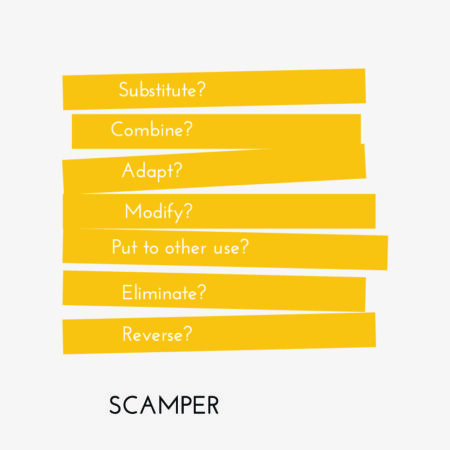Ideas are vital to innovation. They are the seeds from which every innovation grows. When it comes to overseeing an idea management program involving thousands of employees or customers, it is crucial that the process is structured in a way that helps participants to generate the best ideas. In this blog, we highlight eight techniques for idea generation in business that will help your idea management participants to reach their creative potential.
We’ve all been there. Your manager has asked you to come up with a few quick wins and, under pressure, your creative well has suddenly run dry. Ideation is a creative process so it can be challenging to come up with great ideas on demand. It can also be difficult to detach yourself from the same old thought processes and approach a problem or a topic from a new perspective.
This is as true for groups as it is for individuals. Maybe you’ve found that your idea management participants aren’t yielding as many good ideas as in the past. This could be because the team is always addressing each problem in the same way. There are many ways of thinking about a single issue. By sticking to one, you may find that your employees are struggling to deliver the quantity and quality of ideas needed to drive your innovation goals.
Luckily, anyone can improve their creative output by leaning on a few tried and tested techniques. We’ve identified eight of the best methods of generating business ideas that you and your employees can use to unleash your creativity. No more waiting around in vain for those moments of inspiration!
Eight of the best idea generation techniques
First Principles
This is an idea generation technique that strips away all of the assumptions you might have made about something until you are left with a set of essential truths. First coined by Aristotle, the term has been around for more than 2,000 years. Today, ‘first principles’ is an approach to problem solving that has been popularized by contemporary thinkers and entrepreneurs, notably Elon Musk.
Oftentimes, we ‘reason by analogy’. This means we address problems based on our own assumptions or beliefs, or on a set of best practices that is shared by our company or our industry as a whole.
That might work when solving some issues, but those assumptions might obscure a basic truth about a problem that can help to identify a ground breaking solution.
First principles thinking begins by identifying and defining every assumption you or your group has made about the subject. Then, you break down the subject into its fundamental building blocks, or ‘unassailable truths’. Finally, you create new solutions based on those truths, and not on your assumptions.
SCAMPER

SCAMPER is an acronym for seven ‘jumping off points’ you can use to ask different questions about an existing product, service or process.
- Substitute: “Are there any elements that I can substitute for something else?”
- Combine: “What if I combined X with Y?”
- Adapt: “Could this be adapted for another use case?”
- Modify: “Would tweaking this element improve the whole?”
- Put to another use: “Who else could use this product?”” What if we used its waste to create a new one?”
- Eliminate: “Can we make this simpler or more efficient by getting rid of X?”
- Rearrange or Reverse: “What would happen if this process was reversed?” “How would the user experience change if we switched the order of these steps?”
Think of an innovation. The chances are, it changed the status quo by doing one or more of these things. Smartphone touchscreens were invented by combining the display with the keypad. When direct-to-consumer brands like Warby Parker and Casper launched, their business models eliminated third-party retail from the customer journey.
The SCAMPER technique offers a methodical approach to thinking about different aspects of your product, service or process, and posing various questions that can lead you to your next great idea.
The Five Whys
This is a technique that was developed in the 1930s by Sakichi Toyoda, the founder of Toyota Industries (although it may sound familiar if you have children!) Essentially, it involves asking an initial question and then repeatedly asking ‘why?’ until you get to the essence of a problem.
This is a tool that can work effectively in groups but also individually. Define a problem and then ask the first ‘why?’. For each of your answers, ask ‘why?’ up to four more times. The thinking is that by the end of the process, you should have identified the root cause of the overall problem, and the path to tackling it should have become clearer.
Forced Relationships
Forced relationships are an effective way of generating ideas for new products and services and can be used individually or in a group setting.
You take an object or keyword related to your product or business and then you pick a few other words that are completely unrelated to it. The task is to force connections between these words and generate new ideas in the process.
For example, lets imagine that 3D food printers were invented this way. A team at a printer manufacturer combines the word ‘printer’ with the unrelated word ‘food’. That gets them to thinking about how food could be created using the printing process, and the idea of a 3D food printer is born!
Reverse Brainstorming
Ever noticed that it is easier for people to identify problems than to find solutions? Reverse brainstorming is a method for idea generation in business that capitalizes on that.
After posing a problem, the team thinks of all the ways it could make it worse. They might explore ways that costs could be increased, or elements of the user experience that customers would hate. Once this set of problems has been identified, the team can work back to generate ideas that are proofed against the issues they explored in the first part of the exercise.
Six Thinking Hats
The Six Thinking Hats technique was developed by Maltese inventor and philosopher Edward de Bono in his 1985 book of the same name. It’s a method that lends itself particularly well to group ideation but can also be used individually.
It involves exploring an issue from six perspectives. A group can either split into six with each participant or subgroup focusing on one of these areas or ‘hats’. Alternatively, the whole group can work through each in turn.
- The Blue Hat: Process
The blue hat oversees the session. It lays out the agenda and the roles of the other five hats.
- The White Hat: Data
This is all about information. What knowledge has already been gathered and what remains missing?
- The Green Hat: Creativity
This is the hat that concentrates on generating solutions or ways forward.
- The Yellow Hat: Positivity
The yellow hat is all about optimism: identifying and promoting the benefits of the proposed ideas or solutions.
- The Red Hat: Emotions
When wearing the red hat, you are free to share your gut instincts or feelings about the problem or the proposed solutions without having to rationalize them.
- The Black Hat: Downsides
This hat explores the potential risks involved for each solution, casting a critical eye over the group’s ideas and explaining any concerns.
By ensuring that these six key perspectives are covered, this technique helps us to think rigorously about our ideas. At the end of the session the issue will have been explored in detail. Any gaps in the group’s knowledge will have been identified, and the pros and cons of each solution will have been unpacked.
Wishing
This approach starts by wishing for solutions to a problem, no matter how difficult they would be to implement. Once you have a list of wishes, you or your group can move onto a discussion about how they could be put into effect. It may be that only one or two aspects of a wish will be possible to implement. It could also be the case that different aspects of several wishes could be brought together as part of a combined solution.
Word Banks
Similar to forced relationships, word banks are a tool that generates ideas by connecting words to one another. Word banking is an intuitive and low-effort exercise that helps you to mind-map everything you know about and associate with a topic.
You begin by creating a long list of words or terms that directly or indirectly describe a topic or problem. In doing so, the topic or problem will be broken down into bite-size chunks. Once you or your employees have built your word bank, you can link different words to one another, forming connections that may lead to ideas for new solutions. Many of these connections won’t lead anywhere, but some will combine two or more aspects of your problem in a way that you hadn’t considered before, leading you to your idea.
The process will also help you to identify gaps in your knowledge. When compiling your word bank, you might find that there are some aspects of the topic or problem that you are struggling to find terms for. Whenever that happens, those gaps can be flagged, and you can make a note to carry out extra research.
How idea management software can help you gather, manage, and develop your company’s ideas
Having tried some of these techniques for idea generation in business, you should find that your employees are coming up with a higher number of quality ideas. But how can you keep track of them all and ensure that every idea is collected and evaluated properly? In larger organizations, this can be especially challenging. That’s where idea management software comes in.
Idea management software allows you to invite your employees and other stakeholders to submit, vote and comment on ideas. These ideas can then be developed, reviewed and evaluated by you and your colleagues before being put on the path to implementation.
The very best idea management platforms include a wide range of sophisticated features to help you achieve an effective and efficient process. This includes gamification tools, crowd-voting tools and other functionalities that help you to maximize engagement among your audience, as well analytics and reporting tools that help you track participation and measure the ROI of your innovation initiatives.
Q-ideate: our cutting-edge tool to drive your idea management
Q-ideate is Qmarkets’ flexible end-to-end idea management platform. In addition to all the features outlined above, you can choose whichever business idea generation techniques work for your organization and configure Q-ideate to support them.
There are a couple of ways the platform can be configured to support your chosen techniques. Firstly, you can create an idea workflow that is based around the particular process that you want to follow. For example, you can define a workflow stage specifically for strategically dismantling the idea challenge or question, before you start to ask for actual solutions. This could work especially well with the SCAMPER framework.
Another option is to configure the idea submission form. If you want to receive ideas that are more fully developed, you can create specific criteria that you ask participants to provide input for. You can even assign roles to specific teams or individuals to focus on different aspects of a challenge as per the ‘6 thinking hats’ framework.
Innovation is far from an exact science, and the techniques you use for two audiences or two topics might be totally different. Whichever idea generation strategies or techniques you choose, the Qmarkets platform offers the flexibility needed to support an effective enterprise ideation process.
Find out more about how Q-ideate can power your idea management strategy on our product page.



